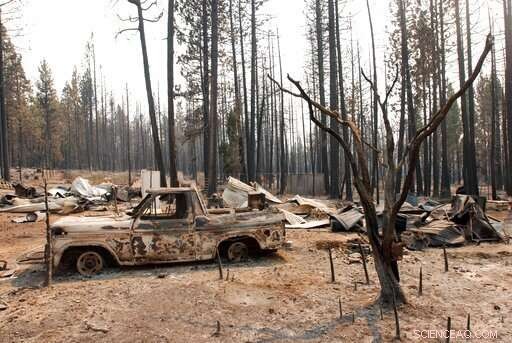
En este miércoles 22 de agosto 2012, foto de archivo, un camión dañado se encuentra entre otros restos en el sitio de una casa rural en las afueras de Manton, Calif., donde un gran incendio forestal ardió el sábado, obligando a los residentes a evacuar. Un análisis de McClatchy revela más de 350, 000 californianos viven en pueblos y ciudades que existen casi en su totalidad dentro de "zonas de muy alto riesgo de incendio". (Foto AP / Jeff Barnard, Expediente)
Pueblos empobrecidos a la sombra del monte Shasta. Ciudades rústicas de la fiebre del oro en las estribaciones de Sierra Nevada. Comunidades turísticas de alto valor en dólares a orillas del lago Tahoe. Ritzy suburbios del condado de Los Ángeles.
Todos podrían ser el próximo paraíso.
Un análisis de McClatchy revela más de 350, 000 californianos viven en pueblos y ciudades que existen casi en su totalidad dentro de "zonas de gravedad de peligro de incendio muy alto", la designación de Cal Fire para lugares altamente vulnerables a incendios forestales devastadores. Estas designaciones han demostrado ser inquietantemente predictivas sobre algunos de los incendios forestales más destructivos del estado en los últimos años. incluido el Camp Fire, el peor en la historia del estado.
Casi todo Paradise está coloreado de rojo brillante en el mapa de Cal Fire; prácticamente toda la ciudad estaba en grave riesgo antes de que el Camp Fire se extendiera en noviembre pasado. quemando la mayoría de las casas a su paso y matando a 85 personas.
Malibú, donde el incendio de Woolsey quemó más de 400 hogares el año pasado, también cae dentro de zonas de muy alto riesgo. Al igual que la pequeña ciudad de Cobb en el condado de Lake, gran parte de la cual fue destruida por el Valley Fire en 2015.
"Hay muchos paraísos ahí fuera, "dijo Max Moritz, un especialista en incendios en UC Santa Barbara.
Todo dicho, más de 2.7 millones de californianos viven en zonas de muy alto riesgo de incendio, desde remolques en tranquilos caminos de tierra en el bosque hasta mansiones en las ciudades más grandes del estado, según el análisis, que se basa en datos del censo a nivel de bloque de 2010. El Departamento de Silvicultura y Protección contra Incendios de California dice que sus mapas muestran lugares donde es probable que los incendios forestales sean extremos debido a factores que incluyen la vegetación y la topografía.
Los mapas no son perfectos en su capacidad para pronosticar dónde será destructivo un incendio. Por ejemplo, el vecindario de Coffey Park de Santa Rosa no se encuentra en una zona de riesgo muy alto, pero fuertes vientos empujaron el Tubbs Fire hacia esa parte de la ciudad, nivelando en gran medida el vecindario en octubre de 2017.
Coffey Park se construyó "sin ninguna consideración por el fuego, "dijo Chris Dicus, un experto en silvicultura y incendios en Cal Poly San Luis Obispo. "El fuego estaba en las montañas; no había ninguna consideración de que el fuego cruzara la (Carretera) 101".
Cal Fire está elaborando nuevos mapas de peligro de incendio, listos en aproximadamente un año, que incorporarán patrones regionales de viento y otros factores climáticos. Mientras tanto, los expertos dicen que los mapas actuales, creado hace aproximadamente una década, todavía proporcionan una guía importante para predecir dónde los incendios forestales podrían causar el mayor daño, De la misma manera, los mapas de llanuras aluviales resaltan las áreas que podrían verse más afectadas durante tormentas severas.
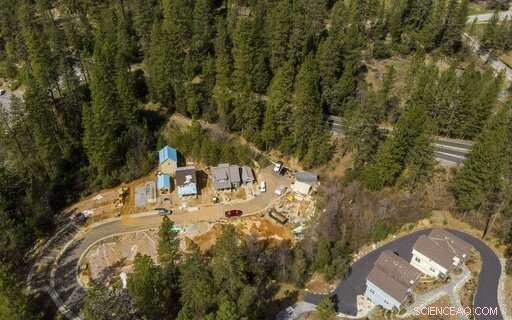
En este 14 de marzo 2019, Foto, un desarrollo de viviendas frente a Chief Kelly Drive en Nevada City, Calif., está en construcción. Las ciudades de California continúan construyendo viviendas en áreas de alto riesgo de incendios forestales. Los funcionarios de la ciudad están de acuerdo en que el bosque atrae, laderas empinadas, estrechas calles residenciales, las casas antiguas y el espeso dosel de árboles urbanos que definen el carácter de la ciudad también hacen que esté particularmente en riesgo si un incendio arde. (Hector Amezcua / The Sacramento Bee vía AP)
Las comunidades en riesgo identificadas por McClatchy también deberían servir como punto de partida para priorizar cómo California debería gastar dinero en modernizaciones y otros programas de seguridad contra incendios. Dijo Moritz.
Los códigos de construcción de última generación de California ayudan a proteger los hogares de los incendios forestales en las áreas más vulnerables, los expertos dicen. Pero los códigos solo se aplican a las nuevas construcciones. Un proyecto de ley presentado por el asambleísta Jim Wood proporcionaría dinero en efectivo para ayudar a los californianos a modernizar las casas más antiguas.
"Esto contribuirá en gran medida a que estos diferentes municipios (al demostrar) que merecen financiación, "Dijo Moritz.
McClatchy identificó más de 75 pueblos y ciudades con poblaciones de más de 1, 000 donde, como el paraíso al menos el 90 por ciento de los residentes viven dentro de las "zonas de gravedad de peligro de incendio muy alto" de Cal Fire.
Aquí hay instantáneas de 10, y los desafíos únicos que enfrentan:
___
Shingletown:un paraíso en miniatura
Población (2010) —2, 283 'en zona de gravedad de peligro de incendio muy alto — 2, 283
Shingletown tiene menos de una décima parte del tamaño de Paradise, pero probablemente conlleva el mismo riesgo.
Como el paraíso la comunidad no incorporada se asienta sobre una loma, y está cubierto de árboles altos y matorrales espesos, ingredientes de un gran incendio forestal. Shingletown originalmente se llamaba Shingle Camp, para los trabajadores que cortaron listones de madera para techos para abastecer a los mineros durante la era de la fiebre del oro.
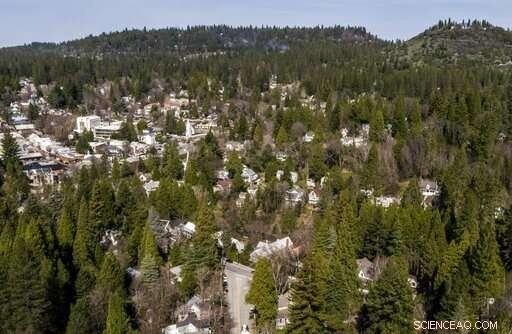
En este 14 de marzo 2019, Foto, El centro de Nevada City está rodeado por una densa zona boscosa, lo que aumenta su riesgo de incendio. Los funcionarios de la ciudad están de acuerdo en que el bosque atrae, laderas empinadas, estrechas calles residenciales, las casas antiguas y el espeso dosel de árboles urbanos que definen el carácter de la ciudad también hacen que esté particularmente en riesgo si un incendio arde. (Hector Amezcua / The Sacramento Bee vía AP)
"Cultivamos árboles como si no fuera asunto de nadie aquí, "dijo Tom Twist, miembro del Consejo de seguridad contra incendios de Shingletown, una organización de voluntarios. Giro, que ha vivido en la comunidad de forma intermitente desde la década de 1970, dijo que cuando el clima sea cálido caminará por su propiedad, arrancando plántulas en un esfuerzo casi inútil por eliminar los combustibles potenciales.
"Saco del suelo 20 o 30 plántulas al día, ", dijo." Es casi como cuando camino hacia allí, hay 20 o 30. Cuando regreso, hay otros 20 o 30 ".
Como el paraíso escapar de la cresta en un incendio rápido no sería fácil; La calle principal de Shingletown es sinuosa, Carretera estrecha 44. Y, como en el paraíso, la presencia de una población mayor dificultaría la evacuación; La edad promedio de Shingletown es 61 años, según cifras del censo.
No es de extrañar que cuando el gobernador Gavin Newsom ordenó a Cal Fire que desarrollara una lista de proyectos urgentes de seguridad contra incendios, un plan para recortar 1, 124 acres de vegetación a lo largo de la Carretera 44 surgieron como la principal prioridad de 35 proyectos en todo el estado.
Los lugareños dicen que están contentos de que el estado esté prestando atención a un problema que conocen demasiado bien. La comunidad tuvo que evacuar cuando el incendio Ponderosa, iniciado por un rayo, golpeó en 2012. El fuego ardió 27, 676 acres — 43 millas cuadradas — e incendiaron 52 casas en los alrededores.
"Somos íntimamente conscientes de los peligros aquí arriba, "Dijo Twist.
___
Nevada City:pintoresca y arriesgada
Población (2010) —3, 068 'en zona de severidad de riesgo de incendio muy alto — 3, 064
Desde el Camp Fire, Vicky Guyette ha visto el parche de un acre de arbustos sin recortar detrás de la casa de la época victoriana de su madre en Nevada City como algo más que una simple molestia poco atractiva.
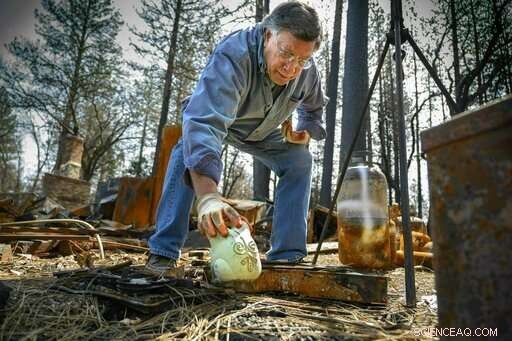
En este 24 de marzo 2019, Foto, Gene Mapa recolecta objetos de metal y cerámica que no se quemaron en el Camp Fire en su casa en Paradise, Calif. Mapa ahora vive en Colfax, que tiene un nivel similar de riesgo de incendio. Un antiguo centro de suministro para campamentos de minería de oro, Colfax se encuentra a unas pocas millas del borde del Bosque Nacional Tahoe en la Sierra de menor elevación. Se extiende a ambos lados de la Interestatal 80 y sirve como la última parada importante entre el área metropolitana de Sacramento y la región de Lake Tahoe. Los caballos pastan junto a los ciervos en grandes ranchos en los escarpados cañones a lo largo de las afueras de la ciudad. (Hector Amezcua / The Sacramento Bee vía AP)
Ahora, la maleza es ominosa, una fuente de ignición que podría incendiar la casa construida en 1859 en la que su familia ha vivido durante cinco generaciones.
La misma ansiedad también se aplica a los cedros, pinos y arbustos que cubren las colinas alrededor de esta ciudad al pie de las colinas de aproximadamente 3, 100 personas, muchos de los cuales viven o trabajan en edificios de madera que datan de la época de la fiebre del oro.
"Da mucho miedo, especialmente porque es un pueblo tan lindo en el que he estado viviendo toda mi vida, "Guyette dijo recientemente mientras caminaba por la histórica Broad Street de la ciudad, que parece que se cayó de una foto de una exhibición de museo.
Los funcionarios de la ciudad están de acuerdo en que el bosque atrae, laderas empinadas, estrechas calles residenciales, las casas antiguas y el espeso dosel de árboles urbanos que definen el carácter de la ciudad también hacen que esté particularmente en riesgo si un incendio arde.
"El mayor riesgo de pérdida financiera y de vidas humanas de la ciudad de Nevada es el fuego, "Se lee en el plan de mitigación de peligros de la ciudad de Nevada.
En décadas recientes, la ciudad también ha tenido algunos accidentes con el fuego, incluyendo una llamada cercana importante.
En 1988, fuertes vientos empujaron el 49er Fire a través de 52 millas cuadradas del oeste del condado de Nevada, quema de 312 edificios y decenas de coches.
"En ese momento se consideró un evento anómalo, ", dijo Billy Spearing del Consejo de Seguridad contra Incendios del Condado de Nevada." No era normal para ellos entonces ".
Con tales incendios convirtiéndose en la nueva normalidad, Cal Fire planea cortar un 1, 802 acres cortafuegos en el suroeste del condado de Nevada en un terreno que no se ha quemado en un siglo, ayudando a proteger tanto la ciudad de Nevada como la comunidad adyacente de Grass Valley, hogar de más de 12, 000.
Nevada City también se embarcó en una campaña en línea "Goat Fund Me" para recaudar $ 25, 000 para contratar a granjeros para que utilicen sus cabras para comer matorrales densos en más de 450 acres de zonas verdes propiedad de la ciudad.
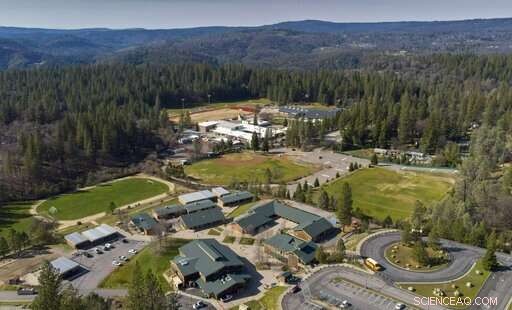
En este 14 de marzo 2019, Foto, Colfax, Las escuelas primarias y secundarias de California están rodeadas de árboles, pero podrían convertirse en una zona segura en caso de un incendio forestal similar al que destruyó Paradise. Un antiguo centro de suministro para campamentos de minería de oro, Colfax sits a few miles from the edge of the Tahoe National Forest in the lower-elevation Sierra. It straddles Interstate 80 and serves as the last major stop between the Sacramento metropolitan area and the Lake Tahoe region. Horses graze beside deer on large ranchettes in the rugged brushy canyons along the outskirts of the city. (Hector Amezcua/The Sacramento Bee via AP)
The goats recently chewed a swath through Pioneer Park near Margaret Rodda's Victorian home, which sits on a steep draw above a creek. But she's still worried.
"All it takes is a drunk with a cigarette, " ella dijo.
The goats inspired Guyette. She said she might spend the $500 to put a herder's goats to work on the thorny thicket of blackberries behind her mother's house.
"We need to get rid of them, " ella dijo.
__
Colfax:Fire is on everyone's minds
Population (2010)—1, 963 ' In Very High Fire Hazard Severity Zone —1, 963
On his first full day in office, Newsom visited the Cal Fire station in Colfax to announce new initiatives on wildfire safety. As he spoke to reporters, surrounded by first responders, he was standing in a city that could burn any summer.
"The people who live here have a true understanding, " said Colfax City Manager Wes Heathcock. "It's always on the back of people's minds, especially with the most recent fires, the Camp Fire. We have a similar makeup here."
At night in the summer, Aimee Costa, who lives on a hill above the elementary school, sometimes keeps her window open, the better to hear ominous sounds.
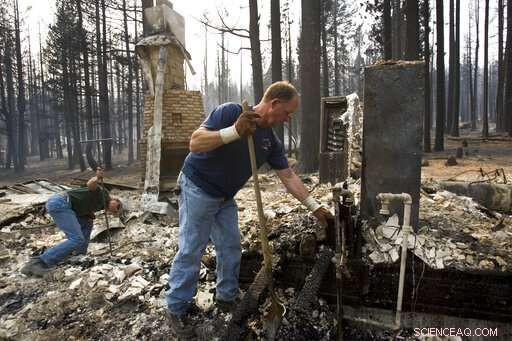
In this 2007 photo, men clear debris after the Angora Fire destroyed hundreds of Tahoe-area homes south of Kings Beach, Calif. Situated on the pristine north shore of Lake Tahoe, Kings Beach is one of the most heavily visited vacation spots in Northern California. That's a big part of the problem. Because so much of the population comes and goes, it becomes harder to get people to treat wildfire risk with the respect it deserves. (Paul Kitagaki Jr./The Sacramento Bee vía AP)
"You're laying in bed . listening for that lick, that smack, that pop sound, " Costa said, describing the sound flames would make if they were chewing pine needles, brush and leaves.
A former supply hub for gold mining camps, Colfax sits a few miles from the edge of the Tahoe National Forest in the lower-elevation Sierra. It straddles Interstate 80 and serves as the last major stop between the Sacramento metropolitan area and the Lake Tahoe region. Horses graze beside deer on large ranchettes in the rugged brushy canyons along the outskirts of the city.
The terrain poses a major fire risk.
In July 2015, the Lowell Fire erupted near Colfax and chewed up thousands of acres along the north side of the freeway, forcing evacuations in adjacent Nevada County. In the years since, Heathcock said the city has been working with state officials on "fuelbreak" projects, including a spot near the high school and elementary school, which has been eyed as an evacuation site.
Gene Mapa, who lived in Paradise and escaped the Camp Fire with some family photographs—and nothing else—has relocated to Colfax, where he already owned a second home. But he knows he hasn't escaped the fire risk; his property just outside the city limits would be threatened by a windy firestorm like the one that engulfed Paradise.
"With that wind, there would be no stopping it anywhere, " Mapa said.
__
Kings Beach:Tourists seek fun, bring fire danger
Population (2010)—3, 796 ' In Very High Fire Hazard Severity Zone —3, 796
Situated on the pristine north shore of Lake Tahoe, Kings Beach is one of the most heavily visited vacation spots in Northern California.
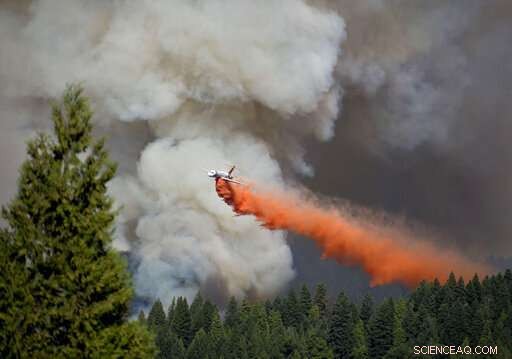
In this Sept. 15, 2014, foto de archivo, a jet drops a load of fire retardant near Highway 50 in El Dorado County near Pollack Pines, Calif. Memories are still vivid of the Sand Fire in 2014. That fire burned 4, 200 acres and 20 homes and came dangerously close to forcing a major evacuation in Pollock Pines and surrounding communities. (Randy Pench/The Sacramento Bee via AP)
That's a big part of the problem.
Because so much of the population comes and goes, it becomes harder to get people to treat wildfire risk with the respect it deserves, said Erin Holland, a spokeswoman for the North Tahoe Fire Protection District. One of the district's six stations is in Kings Beach.
"It is definitely a challenge because we have so many homes that are vacation homes, " she said. "It's really a challenge to educate those visitors . They want to have a camp fire."
Tahoe's vulnerability to major fires was brought home dramatically in recent years. The Angora Fire in 2007, while it was confined to the south shore area, left physical and emotional scars on the entire basin after burning through 3, 100 acres.
Holland said getting the region's property owners and visitors to observe "defensible space" regulations is particularly difficult. Those rules call for clearing brush 100 feet around buildings and include stricter rules regarding vegetation immediately adjacent to structures.
Violators can be subject to citations, but "the goal is to really educate people, to get people complying, " Holland said. "We go the education route rather than the citation route."
__
Pollock Pines:Do the transplants get it?
Population (2010)—6, 877 ' In Very High Fire Hazard Severity Zone—6, 533
Just off Highway 50, a few miles from the tourist haven of Apple Hill, Pollock Pines lures transplants from coastal California, mainly retirees drawn to the lovely stands of trees in the foothill community at the edge of the Eldorado National Forest.
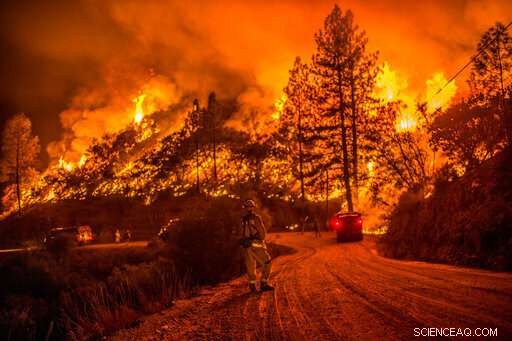
In this 2015 photo, fire crews run controlled burns at night to contain the Butte Fire near Arnold, Calif. In the community that serves as gateway to Calaveras Big Trees State Park, residents didn't always applaud when officials began mapping plans to thin dense stands of trees to reduce fire risk. "Arnold resisted this for a long time because people love their trees, " said Steve Wilensky, a former Calaveras County supervisor who works with nonprofits to improve fire safety in the Sierra. (Andrew Seng/The Sacramento Bee via AP)
Heather Campbell only wishes the newbies had a better understanding of what all that timber represents.
Campbell, a retired U.S. Forest Service employee who's lived in Pollock Pines since the 1990s, is the head of the Pollock Pines-Camino Fire Safe Council, a volunteer group.
In the past few years her organization has received hundreds of thousands of dollars in grants, mainly from the state's "cap and trade" carbon trading program, to trim vegetation on the ridgeline south of Highway 50.
Eso está muy bien ella dijo, but more needs to be done. And the people of Pollock Pines, including the newcomers, have to realize what's at stake.
"Aquí, everybody allows all the saplings and brush to grow and they don't weed it out, " she said. "All these roads are incredibly dangerous, when it's so easy to take out pruners. Take out your pruners!"
She said memories are still vivid of the Sand Fire in 2014. That fire burned 4, 200 acres and 20 homes and came dangerously close to forcing a major evacuation in Pollock Pines and surrounding communities.
"They were going to evacuate 9, 000 personas, " she said. "They were predicting the fire to go to 27, 000 acres, instead of the 4, 000 they stopped it at."
__
Arnold:Trees are falling in Big Trees country
Population (2010)—3, 843 ' In Very High Fire Hazard Severity Zone—3, 843
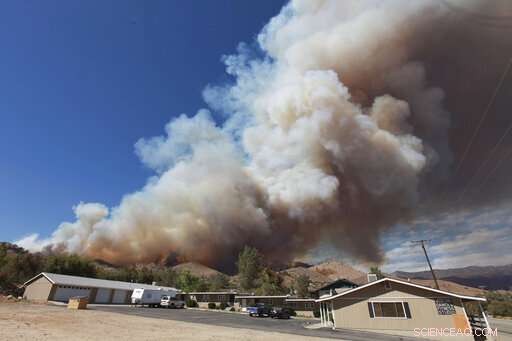
En este lunes Aug. 18, 2014, foto de archivo, smoke rises from a fire in Wofford Heights, Calif. The same powerful desert gusts that attract wind surfers to Kern County's Lake Isabella make the lakeside community of Wofford Heights particularly at risk for wildfire. So does the adjacent Sequoia National Forest, which has been plagued by drought and tree-killing beetles. (Casey Christie/The Bakersfield Californian via AP, Expediente)
In the community that serves as gateway to Calaveras Big Trees State Park, residents didn't always applaud when officials began mapping plans to thin dense stands of trees to reduce fire risk.
"Arnold resisted this for a long time because people love their trees, " said Steve Wilensky, a former Calaveras County supervisor who works with nonprofits to improve fire safety in the Sierra.
After years of protests, Arnold's residents got a major wake-up call in 2015. The Butte Fire, caused by power lines, took out 549 homes in nearby communities. Two people died.
"If the weather hadn't changed, they'd be gone, " Wilensky said of Arnold. "You've got a real parallel with Paradise in some ways . It's a place that is really highly threatened."
Arnold sits on a ridge, surrounded by a dense forest of drought- and beetle-killed trees. Powerful wind gusts can funnel fire up rugged brushy canyons.
A key difference between Paradise and Arnold is that as many as 45 percent of the dwellings are vacation homes, which can sometimes make it a challenge to get out-of-town homeowners to do brush clearing, dijeron los funcionarios locales.
Wilensky said momentum to reduce fire risk has built since the Butte Fire. More than $15 million in state and federal funds have gone to thinning dangerous overgrowth in the region, Wilensky said.
One project includes using bulldozer lines that were cut during the Butte Fire to expand a fire break that stretches to town.
"Arnold is the anchor end of this project, " Wilensky said.
__
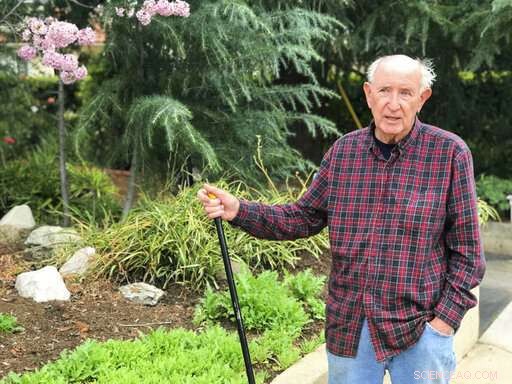
In this March 20, 2019, Foto, Thomas Caswell talks about living on his La Canada Flintridge street for four decades. He said he loves his community, but he has no illusions about the threat of a fire funneling down from the nearby Angeles National Forest. "When it comes down the hill, " él dijo, "nobody is going to be safe." (Ryan Sabalow/The Sacramento Bee via AP)
Wofford Heights:Apathy in a danger zone?
Population (2010)—2, 201 ' In Very High Fire Hazard Severity Zone—2, 147
The same powerful desert gusts that attract wind surfers to Kern County's Lake Isabella make the lakeside community of Wofford Heights particularly at risk for wildfire. So does the adjacent Sequoia National Forest, which has been plagued by drought and tree-killing beetles.
Yet some feel that the region isn't doing nearly enough to combat the threat.
"We could do a hell of a lot more than we're doing, " said Judy Hyatt, who lived in the area for 15 years and served as president of the region's fire safe council. The volunteer group disbanded in recent years from what she and others described as a lack of interest.
En 2016, the Lake Isabella region suffered through the Erskine and Cedar fires, which burned more than 77, 000 acres and more than 300 structures. An elderly couple was killed when they were trapped by the Erskine Fire.
According to census figures, the median age of those living in Wofford Heights is 62, and many live in places with poor escape routes.
"Some of those mobiles up there, honest to God, I think they've dropped them out of the sky, " Hyatt said. "The roads are so narrow, and it really just presents an obstacle and the only way to really get to it is by air. That is when people start to die."
Hyatt said the loss of the nonprofit Kern River Fire Safe Council she once headed doesn't bode well for the community. She said the council organized wood-chipping drives to encourage residents to remove wood debris and sought grants for fuel breaks and other thinning projects.
She said too many locals have grown complacent.
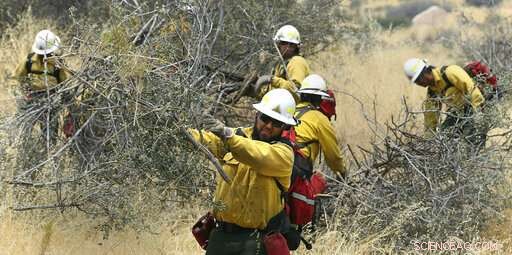
En este lunes 22 de agosto 2016, foto de archivo, workers cut brush off Highway 155, west of Wofford Heights, Calif., as part of fuel reduction for the Cedar Fire. The same powerful desert gusts that attract wind surfers to Kern County's Lake Isabella make the lakeside community of Wofford Heights particularly at risk for wildfire. So does the adjacent Sequoia National Forest, which has been plagued by drought and tree-killing beetles. (Casey Christie/The Bakersfield Californian via AP, Expediente)
"Fire prevention is a nebulous thing, " she said. "It's hard to quantify, until there's a damned fire that takes out everything."
__
La Cañada Flintridge:Is aggressive fire prevention enough?
Population (2010)—20, 048 ' In Very High Fire Hazard Severity Zone—20, 048
Carol Settles and her family evacuated their home in La Cañada Flintridge during the Station Fire in 2009. But she isn't terribly worried about a repeat performance—even though her home is on a dead-end street below a brushy hillside of the Angeles National Forest. Large electrical transmission lines run along the wooded draw behind her home.
"We've never seen a spark, " Settles said, referring to the power lines. "We've never seen any of that."
Best-known as home to NASA's Jet Propulsion Laboratory on the outskirts of Pasadena, the upper middle-class city has an aggressive fire-prevention program. The Los Angeles County fire department checks properties in Settles' area once a year to make sure vegetation has been cleared and hazardous landscaping hasn't been planted.
Fines can be issued for non-compliance. Recientemente, one of Settles' neighbors had to saw off the top of a pine tree because it was too close to a transmission tower, ella dijo.
Los Angeles County's assistant fire chief, J. Lopez, said La Cañada Flintridge has embraced rigorous fire-safety standards, which include annual landscaping inspections and stringent fire-safe building codes, even for large home remodels. Lopez said La Cañada Flintridge also chose to place the entire city inside a high fire hazard zone, going beyond the recommendation of Cal Fire. That decision translates into citywide enforcement of its fire-resilient building codes.
"That's a very progressive way to look at it, " Lopez said.
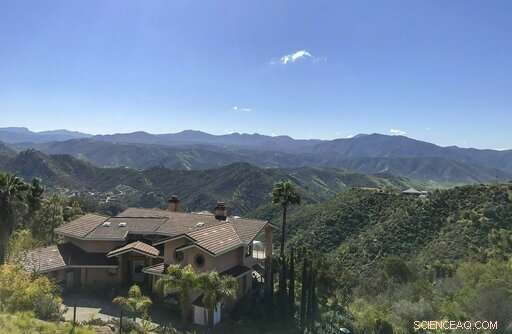
En este 22 de marzo, Foto 2019, a newer home sits along a ridge above Harbison Canyon in San Diego County, Calif. Every 30 years or so, a massive fire blows through Harbison Canyon, 30 miles northeast of San Diego. The 1970 Laguna Fire destroyed much of the unincorporated town that sits inside the canyon and shares its name. Harbison Canyon was rebuilt again after the Cedar Fire burned through in 2003, destroying 287 of the 388 homes. (Ryan Sabalow/The Sacramento Bee via AP)
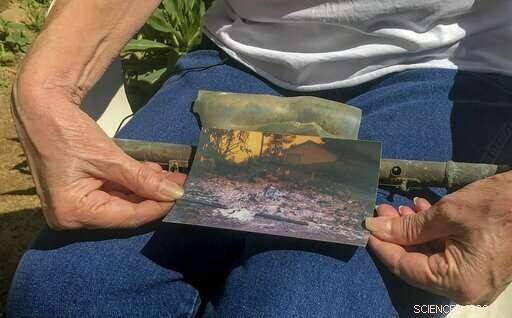
En este 22 de marzo, 2019, Foto, Cheri Skipper, a Harbison Canyon resident, holds her burned flute and a picture showing what her home looked like after it burned during the Cedar Fire in 2003. Every 30 years or so, a massive fire blows through Harbison Canyon, 30 miles northeast of San Diego. The 1970 Laguna Fire destroyed much of the unincorporated town that sits inside the canyon and shares its name. Harbison Canyon was rebuilt again after the Cedar Fire burned through in 2003, destroying 287 of the 388 homes. (Ryan Sabalow/The Sacramento Bee via AP)
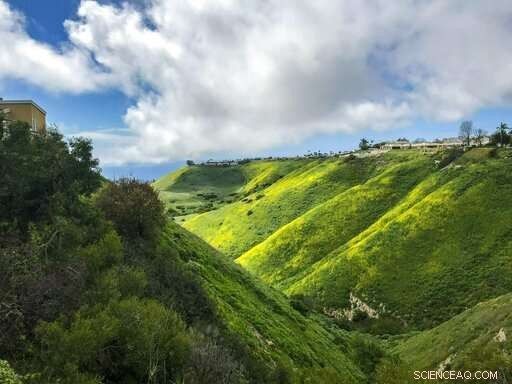
En este 21 de marzo, 2019, Foto, homes line one of the canyons in Rancho Palos Verdes, Calif. The many acres of open space in the city provide breathtaking views and public access to wild places between city subdivisions, but the vegetation poses a substantial fire risk. Rancho Palos Verdes holds a dubious honor:It's the most populated city in California to have 90 percent or more of its population living within a "very high fire hazard severity zone." (Ryan Sabalow/The Sacramento Bee via AP)/The Sacramento Bee via AP)
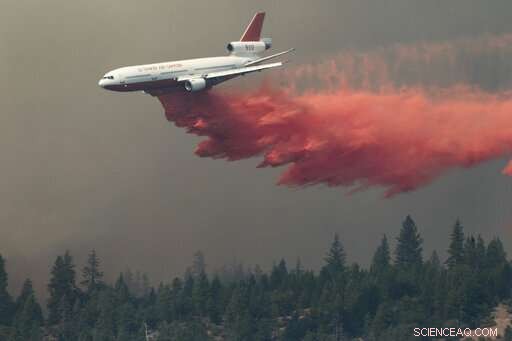
En este lunes 20 de agosto 2012, foto de archivo, a DC-10 drops fire retardant on the Ponderosa Fire near Paynes Creek, Calif. A McClatchy analysis reveals more than 350, 000 Californians live in towns and cities that exist almost entirely within "very high fire hazard severity zones." (Andreas Fuhrmann/The Record Searchlight via AP, Expediente)

En este martes Nov. 4, 2003, foto de archivo, President George W. Bush views fire damage with San Diego County supervisor Dianne Jacob during a tour of Harbison Canyon, outside of San Diego. Every 30 years or so, a massive fire blows through Harbison Canyon, 30 miles northeast of San Diego. The 1970 Laguna Fire destroyed much of the unincorporated town that sits inside the canyon and shares its name. Harbison Canyon was rebuilt again after the Cedar Fire burned through in 2003, destroying 287 of the 388 homes. (AP Photo/Charles Dharapak, Expediente)
But since 2008, on average only about a dozen new homes have been built in La Cañada Flintridge each year, meaning most of the housing stock was built before the rigorous fire standards were in place.
The city's hazard mitigation plan notes many of those older homes still have "combustible roofing, open eaves, combustible siding, " and they're on "steep, estrecho, poorly signed" roads that make evacuations dangerous.
Thomas Caswell, who's lived for four decades on a hilly, estrecho, dead-end street not far from city hall, said he knows the greenbelt behind his house where he watches possums, birds and other wildlife also makes the community vulnerable to fire. It's why he says he didn't mind paying when the city told him he needed to hire a tree service to remove dying trees in his front yard.
Todavía, he knows such efforts probably wouldn't do much good if the Santa Ana winds pushed a fire into the city. Fire officials said that La Cañada Flintridge could have burned in the Station Fire if the Santa Ana winds hadn't stopped blowing. The fire burned 89 homes in outlying communities and 160, 577 acres of forested lands, the largest fire by land mass in Los Angeles County history.
"Once it comes down the hill, " Caswell said, "nobody is going to be safe."
__
Rancho Palos Verdes:Few fears in an affluent suburb
Population (2010)—41, 803 ' In Very High Fire Hazard Severity Zone—40, 550
Rancho Palos Verdes holds a dubious honor:It's the most populated city in California to have 90 percent or more of its population living within a "very high fire hazard severity zone." But few residents seem to think their suburb is in the same league as Malibu, where hundreds of homes burned last fall just up the Los Angeles County coastline.
"It's not like living in Malibu, definitely, " said Gregory Lash as he strolled through a public access walkway in the Trump National Golf Club with his wife, Vivian, on the way to an oceanside park where a pod of dolphins and whales were breaching.
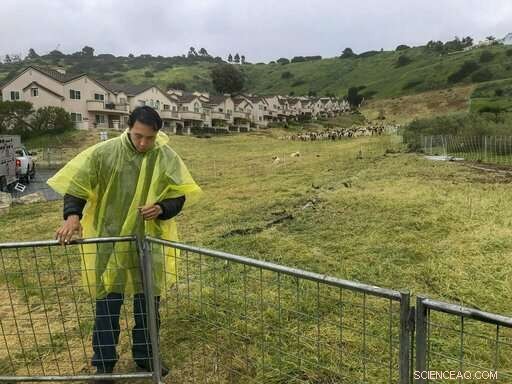
En este 21 de marzo, 2019, Foto, Michael Choi, the owner of Fire Grazers Inc., adjusts a goat pen in Rancho Palos Verdes, Calif., on a rainy day. The city paid Choi $100, 000 for his goats to eat vegetation on about 60 acres over the course of three months. The goats reduce fire risks around homes. Rancho Palos Verdes holds a dubious honor:It's the most populated city in California to have 90 percent or more of its population living within a "very high fire hazard severity zone." (Ryan Sabalow/The Sacramento Bee via AP)
Él agregó, moments later:"Hope that's not naive."
City officials say it's not.
"This being a coastal community, we don't get the type of brush and that kind of fire behavior that you might get in somewhere like Paradise, " said Scott Hale, an assistant fire chief for Los Angeles County. The county leads firefighting efforts on the Palos Verdes Peninsula, whose four affluent communities all fall inside a high fire severity zone.
Locals point out that over the years, the firefighters at the five stations on the peninsula have quickly knocked down the relatively small fires that popped up.
Todavía, Rancho Palos Verdes' hazard mitigation plan lists wildfire as a bigger threat to the city than earthquakes, tsunamis and landslides. Powerful winds that blow from the coast could funnel a fire up the greenbelts that cut through the peninsula's neighborhoods, many of which have opulent homes perched above canyons.
Much of that open space has been preserved by the Palos Verdes Peninsula Land Conservancy, which manages more than 1, 600 acres of land in and around the city. Residents such as Lash love the 42 miles of trails on conservancy lands, but all that undeveloped acreage could ignite, said Gabriella Yap, deputy city manager.
"You're trying to preserve that, but it also comes with fire risk, " Yap said.
The city's staff supports Southern California Edison's plans to trim vegetation from under the lines that run through some of the open space to reduce fire threats, but the land conservancy is bristling at the loss of native habitats.
"The environmental impact of that is really significant, " said Adrienne Mohan, the conservancy's executive director.
__
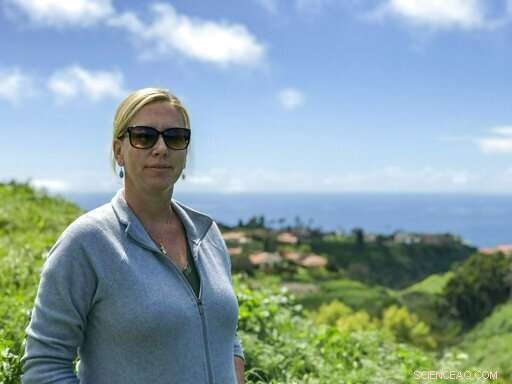
En este 21 de marzo, 2019, Foto, Adrienne Mohan, the executive director of the Palos Verdes Peninsula Land Conservancy, stands above acreage her organization maintains in Rancho Palos Verdes, Calif. Rancho Palos Verdes holds a dubious honor:It's the most populated city in California to have 90 percent or more of its population living within a "very high fire hazard severity zone." But few residents seem to think their suburb is in the same league as Malibu, where hundreds of homes burned last fall just up the Los Angeles County coastline. (Ryan Sabalow/The Sacramento Bee via AP)
Harbison Canyon:Will it burn a third time?
Population (2010)—3, 841 ' In Very High Hazard Fire Severity Zone—3, 841
Every 30 years or so, a massive fire blows through Harbison Canyon, 30 miles northeast of San Diego.
The 1970 Laguna Fire destroyed much of the unincorporated town that sits inside the canyon and shares its name. Harbison Canyon was rebuilt again after the Cedar Fire burned through in 2003, destroying 287 of the 388 homes.
Rick Halsey of the Chaparral Institute said the canyon is a painful example of how development has been allowed to continue practically unchecked for decades into some of California's most fire-prone places.
"You want to create a geographical hotspot for fire, you couldn't put it in a better place, " said Halsey, whose environmentalist organization was founded to fight calls for clearing hundreds of square miles of wild lands following the Cedar Fire. "It's like a bowling alley for the Santa Ana winds."
That sort of talk makes longtime resident Mary Manning cringe.
She worries that focusing on the canyon's fire risk creates the impression that the community she loves can't be saved from the next catastrophe. She said her community could be made more safe if state and local officials would invest in infrastructure and fire prevention that matched the rates of development she's seen over the years. Por ejemplo, the side streets in Harbison Canyon are narrow. Some, like Manning's, remain unpaved despite decades of building.
"There were five houses, now there are 35, " she said of the street she's lived on since 1975.
Manning notes it was only two years ago that the local fire station became staffed 24 hours a day—14 years after the Cedar Fire. Inside the station, Dave Nissen, the Cal Fire official who oversees firefighting in the area, said there are a number of challenges to fighting a fire in the canyon, including the narrow roads and houses stacked close together.
Nissen said firefighters reduce the risks by inspecting lots every year to make sure they're not overgrown. On that front, Harbison Canyon's residents don't seem to need too much prodding, judging from the roar of chain saws and weed trimmers echoing through the canyon on a recent spring weekday afternoon.
© 2019 The Associated Press. Reservados todos los derechos.